You are currently browsing the tag archive for the ‘womens prison’ tag.

NO BARS, NO GUARDS, NO LOCKS
Tattered lace curtains, taped family photos, patterned carpets, plastic flowers and snappy fabrics. Gabriela Maj’s portraits from the series Almond Garden have all the chirpy, easy-to-patronize details of portraiture from a former Soviet controlled region. Lost you already? Think of Sergey Poteryaev’s portraits, Rafal Milach’s Winners in Belarus, Olya Ivanova’s portraits of young girls in rural Russia or anything by Sasha Rudensky. More directly consider the backdrops photographed by Lucia Ganieva.
(As much as I hate top-loading an article with links to a host of other photographers, I must because before we can understand how special and different Maj’s work is, we must appreciate the en vogue photo practices from which it emerges and above which it must rise.)

For the moderately trained eye, Maj’s work is obviously anchored within a super-region that still carries the visual culture of its immediate past. No matter how hard former Soviet countries try, nor how quick they build, photographers still seem to be able to isolate the details that’ll whiplash people back in time. The problem I outline here is twice as tricky because we, in the west, think that all changes in the former USSR since the end of the Cold War must at least be headed in the right direction.
The framework I am trying to set up here, basically, is that in which Soviets — and all those formerly-ruled by them — are ‘Othered’ and misunderstood by most viewers looking at photographs made in the region. I offer a word of caution before you step into Maj’s portraits. The stories burdened by the women in Maj’s Almond Garden are devastating and the worst thing we can do with Maj’s work is to lump it in with all that work of the knackered Russian empire.
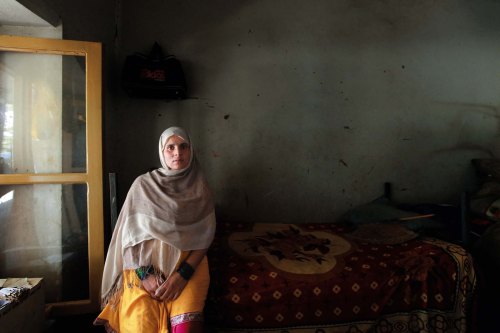
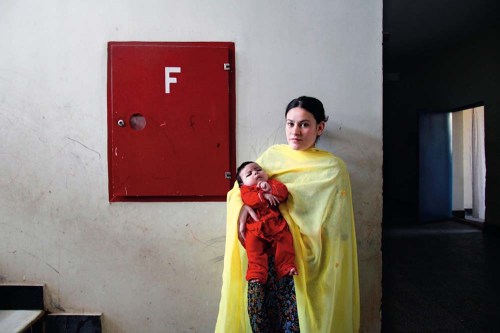
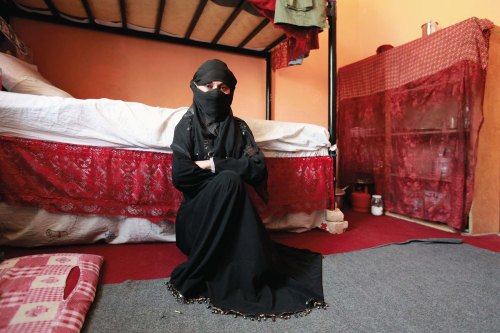

Over the course of four years (2010 – 2014), Polish Canadian photographer Gabriela Maj travelled throughout Afghanistan to collect portraits and stories from inside the country’s women’s prisons. She visited with many of her subjects on multiple occasions.
Maj actually believes that being of Polish origin helped her to gain relatively unhampered access. Poland and Afghanistan shared a history of Soviet oppression.
It also helped being a woman. In fact, her mode and ability of movement revealed the so very twisted logic of a prison system that brutalised women.
“As a solitary female photographer, accompanied only by an Afghan interpreter, I was frequently left alone in the prisons once our guard escort tired of monitoring me. My sense was that unaccompanied by any security, a woman, albeit a foreign one, was not considered a threat,” she writes in an essay featured in the book. “Being overlooked in this way became a strategy that ultimately exposed the context within which I was working, one where women’s narratives were considered irrelevant to the power dynamics that ran the country.”
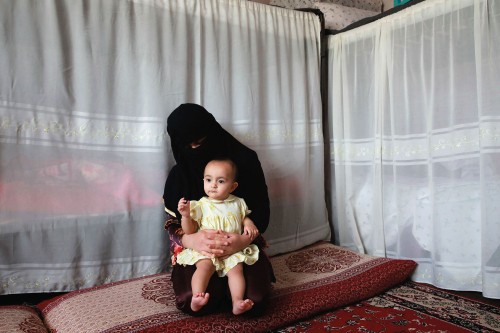
Maj went the extra mile and then some. The least we can do it get there with her. The majority of the prisoners Maj documented were incarcerated for what are known in Afghanistan as “moral crimes,” a term used to condemn those who’ve had sex outside of marriage, or run away from any number of abuses — forced marriages, being sold into prostitution, domestic slavery, physical violence generally conducted by their husbands, and rape and involuntary pregnancy.
Indeed, the portraits are powerful but it is the relentless injustice of the testimonies of the women that delivers the power and absolute necessity of Almond Garden. Maj has changed the names of the women to protect their privacy. She goes a step further and moves the stories to the back of the book.
“Separating the portraits from the stories has allowed for a record of the experiences of this group without any one woman being defined by the crime she was accused of,” explains the press release.
Each entry leads with the offense that the woman is accused with, her age and the length of her sentence.
I haven’t been so effected by a project pairing portraits of women with their transcribed words since, strange as it might be to offer, Malcolm Venville’s The Women of Casa X, which features portraits of aging sex-workers in Mexico. But, then again, perhaps not so strange? Both the women in Melville’s work and the prisoners in Maj’s work have been categorized, judged, ostracized and maligned by dominant patriarchal culture. In both cases, if the photographer hadn’t shown up, these stories would be buried (which is the culture’s intent, right?)
“Often times rejected by their families, these women’s situations can become grave after they are released,” says the Almond Garden‘s blurb. “Without the protection of their relatives that spurned them, they are often in very real danger of being killed or tortured unless they are able to seek refuge in a women’s shelter.”
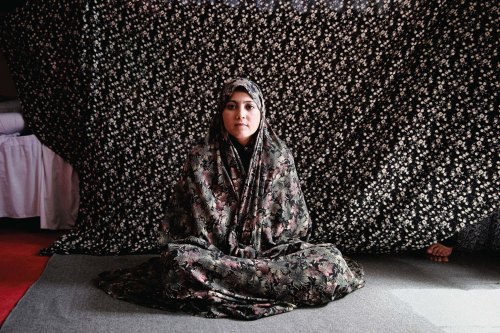
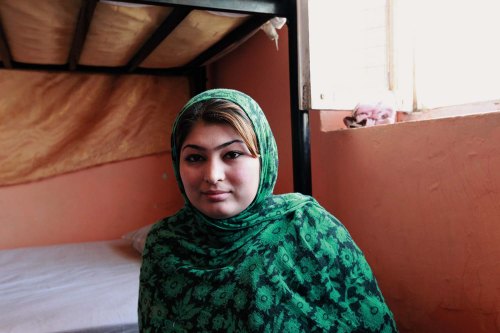
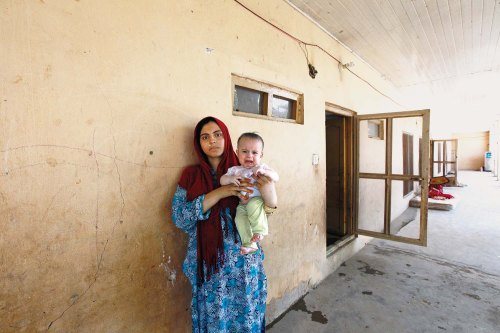
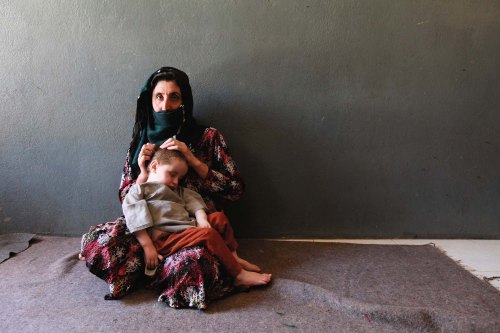
It is bittersweet to think of these tortured moments in prison might be, for some women, where emotional and physical trauma exists least. That said, there is no psychological treatment or therapy available within the prisons Maj visited.
The title of the book Almond Garden is a play and is incongruous. It is the English translation of Badam Bagh, the name of Afghanistan’s most notorious penitentiary for women, located on the outskirts of Kabul.
Almond Garden publishers, Daylight Books, say that Maj’s project is the “largest record documenting the experiences of incarcerated women in Afghanistan produced to date.”
It’s stunning. It works in waves as all good photography should. I’ve been drawing important lessons from Almond Garden each time I’ve returned to it. Aesthetically, it’s as good as Michal Chelbin’s Swans and Sailboats, portraits from Ukraine and Russia. Ethically, I think it surpasses it as Chelbin is evasive about the details of her access.
BOOK TOUR, NOW!
Maj is currently on book tour.
Los Angeles tonight! If you’re in San Francisco, hit up one of her two events next week. On May 5th, at Modern Times Bookstore, or on May 6th at The Women’s Building.
BUY THE BOOK
Here, for $45.00.
DATES ON THE ALMOND GARDEN BOOK TOUR
May 1st, Exhibition and book signing with Daylight Books at the Leica Gallery in West Hollywood, CA.
May 5th, Presentation and book signing at Modern Times Bookstore in San Francisco, CA.
May 6th, Presentation and book signing at the Women’s Building,7:30-9:00, San Francisco, CA.
May 9th, Presentation and book signing at Apostrophe Books, 5:00-7:00pm, Long Beach, CA.
May 22nd, Presentation and book signing hosted by the Vermont Professional Photographers Association and the Peace and Justice Center, 6;00-8:00, Burlington, VT.
July 31st, Exhibition opening and book signing at Daylight Project Space , Hillsborough, NC.
August 8th, Book signing at Author’s Night 2015, East Hampton, NY.
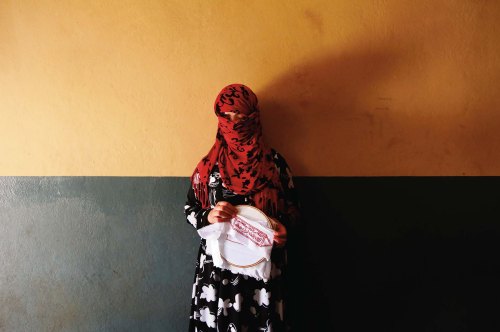

Neve Tirza, which houses 180 women, is Israel’s only women’s prison. In 2011, Tomer Ifrah, a photographer based in Tel Aviv, spent one day a week for three months photographing life inside. Ifrah’s series is Women’s Prison.
“The prisoners come from diverse social backgrounds, and mostly who belong to powerless minorities,” says Ifrah in his artist statement. “They must share their lives in close quarters. Most women in Neve Tirza Prison are serving their second or third terms there, trapped in a vicious cycle.”
Ifrah says that the relationships between the prisoners, the staff and he were rooted in mutual respect and trust. Cursory Google searches of Neve Tirza Prison reveals a history of abuse from 10 years ago; in particular threats to Palestinian prisoners; a recent influx of white collar criminals; and ongoing inhumane allotment of physical space. Neve Tirza has falsely been cast as a “paradise” by American TV. Conditions, on the evidence of our conversation, have since improved significantly.
Scroll down for the Q&A. Right click any image for a larger view.


Prison Photography (PP): Tell me about how you got access to Neve Tirza Prison.
Tomer Ifrah (TI): Going into the prison was such a lucky thing – even to get access for one day. I was sent by a local Israeli women’s magazine to photograph a single prisoner. I went to the prison with a reporter.
I had to wait for the reporter to do the interview, so they kept me in one of the segments of the prison. Of the five segments, I was waiting in the “easiest” one – the one in which you are kept if you have good behavior or committed minor crimes. I could talk with the prisoners quite openly.
I realized there was something in Neve Tirza for a project. I was quite skeptical [at the chances of doing a project] but I found out who was in charge and knocked on the door of the manager of the prison. I told her that I was interested in doing a project and she said immediately that it sounded good. After a few days and a few phone calls, I got in.
In the beginning, they didn’t know exactly what I wanted to do; it was the first time someone had go in and photograph the prisoners. They didn’t know exactly what to tell me. I wanted to go a few times a week, but they told me I could go in once a week.
PP: Neve Tirza is the only women’s prison in Israel. What’s the population of Israel?
TI: More than 7.5 million, perhaps 8 million.
PP: Just a single prison for women from such a large population seems incredible.
TI: What are the figures of incarceration in America?
PP: There are more than 200,000 women incarcerated in America. There are 2.3 million American prisoners in total.
TI: In Israel, there are 25,000 men in prison. Approximately, 13,000 or 14,000 are criminals. The remainder are incarcerated on security related issues – mostly Palestinians.
I watched a documentary by a woman who wrote a book about Neve Tirza. After she researched the topic, she was asked, ‘Why is there such a small number of female prisoners?’ She didn’t have a scientific answer, but she noted that it was the only women’s jail in Israel and so, maybe, they fit the prisoners into the space that they have. If you don’t have a place to keep female prisoners, perhaps they convict them less? I’m not sure, but this was the only answer I have found.
PP: On your website, I didn’t see text or information accompanying the images. What’s the main story in Women’s Prison?
TI: This project was made exactly at the time I got involved with Frames Of Reality, a project that is a partnership between Palestinian photographers and Israeli photographers. Each of the photographers could choose a subject, so I chose the prison.
While I was working on Women’s Prison, I came with new images to the group and each week professional photographers saw them. The main thing that came out of our discussion of the images was that Women’s Prison is about feelings, about sensations, about the prisoners and what they go through. I was photographing emotions.
PP: And what were the overriding emotions?
TI: Neve Tirza is a very difficult place to be. It is a very intense place. The atmosphere is not easy. It’s so small.

TI: Neve Tirza is very crowded compared to other jails in which each prisoner has his or her own cell. The women are kept six to a cell in some of the segments. Just imagine going into a very small cell and you have to live with five others? Most of the time – from 7pm until morning – the doors are closed. Outside of those times, you can go outside, but even then it is very crowded. Imagine the conflicts between prisoners in such a small place?
PP: Conflicts? Was it a violent place or was it pressurized?
TI: I can imagine that sometimes it comes to physical violence but I think that mostly it stays at the level of shouting and verbal abuse. But there’s the other side of it; if you stay close to someone for a long period of time, very strong bonds develop. There is lots of caring and love among the prisoners. It feels like a very close family.



PP: Because there’s so few prisoners, I must assume that the women have been convicted of serious crimes? And they come from diverse social backgrounds?
Most of the women are convicted for drugs issues, caught in a cycle. Most women were serving their second or third term. They don’t have any options when they are released. I think this is a universal fact, not just here in Israel.
PP: What do the women who are trapped in this cycle, as you describe it, think of prison? Is it an opportunity to rehabilitate?
TI: It goes both ways. The staff and the manageress are doing their best to help them; you can see it in their interactions. They treat them the best they can. The administration has the best intentions. But on the other hand, it is hopeless, because they don’t feel that they can ultimately help them.
There also is a lot of criticism because most of the people in Neve Tirza are not supposed to be in jail; they are supposed to be in psychiatric hospitals, possibly. When you’re inside there you understand that immediately. A big percentage of the women have mental disorders. If you put people who are unhealthy in their minds together it can be hell for them.
My personal opinion about it is that it doesn’t help anybody. The system must be changed if you want to really help them and not just lock them up away from society. If you really want to help them there are other ways to do it.
PP: What did the women think of you and your camera?
I was surprised. Some of them at first told me that they weren’t interested in being photographed, but there were very few. For the whole period of time, I respected that and didn’t photograph them.
The women I did photograph felt very comfortable being photographed or didn’t give it any special attention. For me, it was excellent because I could document as I wanted.
PP: Did they ask what you’d do with the pictures?
TI: Yes. I told them they were going to an exhibition by Frames Of Reality (the Palestinian/Israeli photographer project) and that it would probably publish in magazines. They were okay with that.
The bigger thing was to get the approval of the warden. She was more difficult [to satisfy] than the prisoners. There were some photographs she didn’t allow to be published.
PP: What photographs did the administration censor?
Photographs that they felt that the families of the victims would be hurt by. If I showed a prisoner sentenced to murder, it would cause difficulties as that a very sensitive issue with the family of the victim.




PP: What I find is quite common in American prison photography projects is there are different levels of complicity and expectations between the prisoners and the staff. And also there can be different motivations for inclusion in – and accommodation of – a photo project between the management of a prison and the staff of the prison.
TI: In the beginning I was helped by both management and staff. Towards the final stages of the project they felt they were taking a chance with me, and with my security. They were worried I might get hurt. They probably have a good sense about what’s going on there, but I felt it only in the final stages.
I feel I didn’t have enough time to photograph the project as I wanted. Even with several hours a week, many things could get in the way. I could lose hours of time making photographs if there was something going on in the prison [that restricted my access]. I can often feel that way with projects, but particularly this one. I said thank you for every minute I had to photograph but still …
PP: Do you know of other photographers who’ve photographed Israeli women in prison?
TI: I only know of one student. It was done well, but not a full body of work. The photographer probably didn’t have much time inside.
PP: Magnum photos has a single lonely image made by Micha Bar Am from 1969.

PP: Is Neve Tirza Prison an ignored topic?
TI: No, no. Everybody wants to get access. I was very lucky. I think if I’d asked six months before I wouldn’t have got access. It was perfect timing. They felt comfortable with me and they trusted me. I wanted to return that trust so every image that I photographed I immediately showed them. I was very honest with them.
The thing that helped me to photograph there most was the fact that the prisoners trusted me. They understood that I would not take pictures that they did not want me to take; I would publish it in an an honest way.
PP: Obviously, a lot of imagery that comes out of the Israel/Palestine region is politicized. I’ve seen some work of Palestinian political prisoners. How does your body of work fit into that visual territory?
TI: I was not allowed to photograph the Palestinian female prisoners, of whom there were very few in Neve Tirza. If it were to cause problems for the prison staff, I was happy to not do that.


PP: Why were you not permitted to photograph Palestinian prisoners?
TI: There is a single image of an Arabic woman praying in her cell. She gave me permission as did the prison. It was okay with her but in one or two cases it was not allowed. The modesty in Arab culture is more strict. If it is men, it is usually okay, but if it is women it is more problematic.
There are many minorities in prison. In my images, you’ll see that many women are not Israeli born. Some of them are from Russia, or Ethiopia, or South America.
PP: Is that because minorities are generally marginalized in Israeli society?
TI: Exactly. I think this is also common in societies other countries.
PP: How many images did you make in total?
TI: I was photographing with medium format film. I made about 500 images in total.
PP: Tell me about Frames Of Reality, the joint Israeli/Palestinian photography project in which you are involved.
TI: Frames Of Reality is in its third year. The meetings are held in Beit Jala, a place near Jerusalem that is easy for both Israeli and Palestinians photographers to get to. We meet once a week with guest photographers or lecturers. It is financed by another country … I don’t know which. At the end of each year Frames Of Reality has a big exhibition and publishes a book.
PP: There’s many good photographers! Dan Balilty, Ahikam Seri, Eman Mohammed, Noah Ben Shalom.
TI: I’m not surprised people know Israeli photographers because the region is such a strong place to make photos.
PP: Specifically with Frames Of Reality, you’re trying to lead by example? Does photography have role to play in bringing different communities together.
TI: I just returned form the Israeli press contest where I saw all the core issues in the photographs – from photographs of East Jerusalem to Palestinian photographers working in Tel Aviv. Photography has role but I don’t know how much influence it has.
PP: Well, I encourage editors to get in touch so your photography can be seen. Thank you, Tomer.
TI: Thanks Pete.


Fourteen female prisoners at Tirgsor Prison in Romania participated in a six-camera workshop led by Cosmin Bumbuţ.
The workshop was suggested by a Miss Raducanu (presumably the warden), and Cosmin Bumbuţ took up the initiative. Bumbuţ gained sponsorship from f64 and insisted that – after basic training – the women be left unsupervised with the cameras for the duration of the project.
Bumbut: “I received six Canon PowerShot cameras that I took with me to Tirgsor in July. The cameras worried me, they had so many buttons and the manual was so complex that I was skeptical that anyone could use them; I, for one, wasn’t able to. I felt very nervous.”



Over a two month period the group captured 14,000 images. 395 were chosen for the final exhibition and 95 can be seen in an online gallery at Punctum (Romanian language). Here is a Google translation.
I’ve picked out 12 images.
This is a marvelous project. I would like to see more photography used as rehabilitation in prisons. I have a colleague who uses video in an ethnological framework and the men really benefit from the novel educational approach.
This Romanian project is similar to the pinhole photography of the girls of Remann Hall here in Washington State.
Finally, it is worth saying that Bumbut was inspired by Klavdij Sluban‘s prison workshops which he has conducted across the globe.









Munkhbayar is the director of the women's prison just outside Ulaanbataar, her background is in Law. © Grace Gelder
Grace Gelder is building a portfolio with some impressive images. She graduated with an MA from Bolton University in International Photojournalism , Documentary & Travel Photography. I am chuffed to promote her work because Bolton is one of many mid-sized cities of England’s Northwest that has been the brunt of dismissive attitudes during my childhood and adolescence.
The University of Bolton is helping reshape those ill-informed attitudes and building a reputation for its photojournalism department. This is helped by its partnership with the Dalian College of Image Art, China. Which helps to explain how Gelder came to work on her far-flung series Professional Mongolian Women. Mongolia is just next door, right?
As the Metro puts it, Gelder “counteracts misconceptions of Mongolia as an under-developed country. Her series of striking colour portraits, each depicting one woman in her professional context, follows up a UN report last year that placed Mongolia first in a league table for women’s participation in the workforce.”
I think particularly with her portrait of Munkhbayar, Director of the women’s prison just outside Ulaanbataar, Gelder succeeds in quashing stereotypes that exist regarding Non-western nations, Mongolia itself, and women in those societies. I am just glad Gelder had a prison warden as one of her subjects; as to provide me an excuse to promote her well-informed work. I recommend reading Gelder’s own description of gender relations and equalities in Mongolia.
(Via PhotoMABlog)











